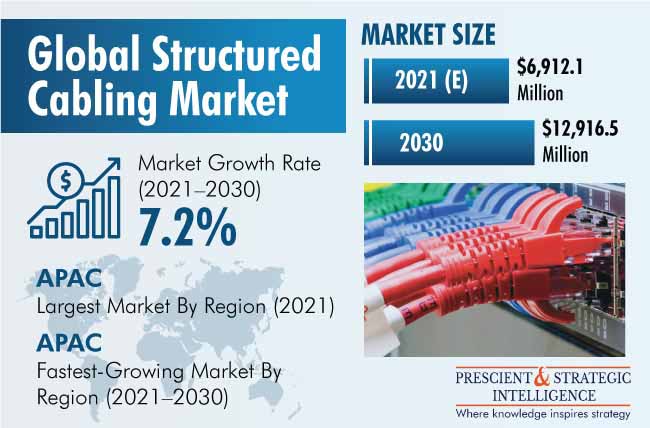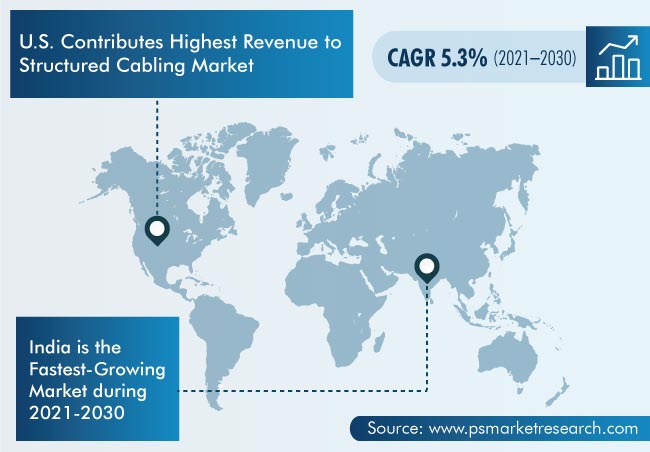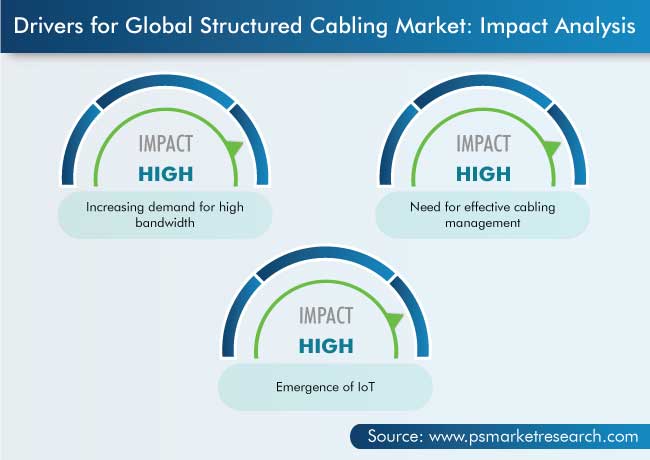Report Code: 10405 | Available Format: PDF | Pages: 189
Structured Cabling Market Research Report: By Product (Copper Cable, Fiber Cable, Copper Components, Fiber Components), Wire Category (Category 6, Category 5e, Category 6A, Category 7), Application (LAN, Data Center), End Use (Telecommunication, Commercial, Government, Industrial) - Global Industry Analysis and Growth Forecast to 2030
- Report Code: 10405
- Available Format: PDF
- Pages: 189
- Report Description
- Table of Contents
- Market Segmentation
- Request Free Sample
Market Overview
The global structured cabling market will generate an estimated $6,912.1 million revenue in 2021, and it is expected to grow at a CAGR of 7.2% during 2021–2030. The key factors responsible for the growth of the market include the increasing demand for high bandwidths and need for effective cabling management and emergence of the internet of things (IoT).
The COVID-19 pandemic across the world has impacted the cabling market. Key economies, including China, India, the U.S., and European countries, witnessed the temporary shutdown of industries due to the lockdowns implemented by their governments. The pandemic also impacted the supply of electrical components to original equipment manufacturers (OEMs), which, in turn, impacted the manufacturing of cabling solutions, thus negatively impacting the growth of the market.

Copper Cables and Local Area Network (LAN) Categories Dominated Market
The copper cables category holds the largest share in 2021 in the structured cabling market, based on product. This is attributed to the lower price of copper cabling, as compared to fiber cabling and the additional cost incurred in setting up the infrastructure for fiber cablings.
The LAN category has had the larger share in the structured cabling market during the historical period (2017–2021), based on application. This is primarily due to the fact that LANs provide greater flexibility within a company as they can be used to connect devices such as computers, photocopiers, and printers, while also integrating phones and surveillance cameras into the network, thus, essentially making devices independent.
Category 7 and Industrial Category to Witness Fastest Growth
Category 7 cablings are expected to witness the fastest growth in demand in the market during the forecast period, based on wire category. Cat7 standard cablings provide 10-Gigabit ethernet over 100 meters of copper cabling. Owing to the shielding property of Cat7 cablings with twisted pairs, noise resistance improves significantly.
The industrial category is expected to witness the fastest growth in the market during the forecast period, based on end use. This will primarily be due to the surging demand for industrial automation and increasing use of cloud services in the manufacturing sector.
APAC To Lead Market due to Increasing Number of Data Centers and Rising Demand for High-Speed Internet
Geographically, Asia-Pacific (APAC) is expected to lead the cabling market throughout the forecast period due to the increasing number of data centers and rising demand for high-speed internet. China, Japan, South Korea, and India are expected to play a pivotal role in driving the growth of the APAC structured cabling market in the coming years, by transforming themselves digitally, for which fast and smooth internet connectivity is imperative.

Adoption of Structured Cabling by Enterprises Is Key Market Trend
Structured cabling is costlier than conventional cabling; however, the former significantly reduces overall operational costs, which include costs incurred as a result of slow data transfer and network failure. According to the International Engineering Consortium (IEC) standards, network systems installed in open offices can reduce the cable maintenance cost by around 30% as compared to alternative office setups. Moreover, cabling unifies the IT network for data, voice, and video, which consequently reduces the requirement for updates and lowers the cost of maintenance. This attracts business enterprises planning to slash down the extra charges incurred by conventional cabling, as structured cabling can reduce the cabling-related costs of an organization by around 20%.
Moreover, companies in the market are increasingly focusing on advanced cabling to meet the higher data requirement at a higher speed. For instance, in June 2021, CommScope Holding Company Inc. launched the NOVUX portfolio of outside plant terminals and closures, designed specifically to assist global fiber service providers in the quick and efficient deployment of fiber networks. The products constitute an end-to-end architecture that allows operators to scale and shape their networks.

Increasing Demand for High Bandwidth and Need for Effective Cabling Management Boosting Market Growth
The increasing penetration of the internet has spurred the demand for high bandwidths for the smooth operation of businesses, which can be provided by cabling. Business organizations are modifying their IT infrastructure owing to the increasing usage of bandwidth-intensive applications, such as voice over IP (VoIP), IP-based videoconferencing, and digital audio and video. Cabling is receiving attention from sectors such as telecommunications, government, industrial, and commercial to improve their IT infrastructure.
Structured cabling makes cabling management simple as it can be laid and managed without the involvement of a large number of staff members. Therefore, the surging demand for hassle-free IT infrastructure drives the market for structured cabling as it saves the cost as well as time for data centers, government agencies, and industries. It is a more-organized- and -standardized approach as compared to patch cords.
| Report Attribute | Details |
Historical Years |
2017-2021 |
Forecast Years |
2022-2030 |
Base Year (2021) Market Size |
$6,912.1 Million |
Market Size Forecast in 2030 |
$12,916.5 Million |
Forecast Period CAGR |
7.2% |
Report Coverage |
Market Trends, Drivers, and Restraints; Revenue Estimation and Forecast; Segmentation Analysis; Country Breakdown; Impact of COVID-19; Companies’ Strategic Developments; Company Profiling |
Market Size by Segments |
By Product; By Wire Category; By Application; By End Use; By Region |
Market Size of Geographies |
U.S; Canada; Germany; France; U.K.; Italy; Spain; Japan; China; India; Australia; South Korea; Brazil; Mexico; Saudi Arabia; South Africa |
Explore more about this report - Request free sample
Market Players Involved in Product Launches to Gain Significant Position
The structured cabling industry is fragmented in nature with the presence of several key players.
In recent years, players in the structured cabling industry have been involved in product launches in order to attain a significant position. For instance:
- In June 2021, Legrand North America LLC launched a do-it-yourself (DIY) for relocating hard-to-reach outlets. The kit provides an option for moving power or charging access out from behind a dresser, bed, nightstand or couch without the clutter of a long and unsightly extension cord or cable and allows the furniture to be placed flush to the wall, if desired. The kit is electrical-code-compliant and allows a homeowner to complete the installation using only a few common tools.
- In February 2021, Panduit Corp. launched the 400G Next-Generation connector-based solutions (CS) connector to optimize data center fiber to rack density. The push–pull connector and unitary cable design reduce the congestion in pathways and allow for easy access in high-density applications, without disturbing adjacent circuits.
Key Players in Global Structured Cabling Market Include:
- Schneider Electric SE
- TE Connectivity Ltd.
- ABB Ltd.
- CommScope Holding Company Inc.
- Corning Incorporated
- Panduit Corp.
- Nexans S.A.
- Belden Inc.
- Furukawa Electric Co. Ltd.
- Siemon Company
- Legrand Holding SA
Market Size Breakdown by Segments
The global structured cabling market report offers comprehensive market segmentation analysis along with market estimation for the period 2017-2030.
Based on Product
- Copper Cable
- Shielded twisted pair (STP)
- Foil-screened twisted pair (FTP)
- Unshielded twisted pair (UTP)
- Fiber Cable
- Multi-mode (MM) fiber
- Single-mode (SM) fiber
- Copper Components
- Copper patch cords
- Copper patch panel ports
- Cooper outlets
- Fiber Components
- Fiber patch panel ports
- Fiber outlets
- Fiber patch cords
Based on Wire Category
- Category 6
- Category 5e
- Category 6A
- Category 7
Based on Application
- Local Area Network (LAN)
- Data Center
Based on End Use
- Telecommunication
- Commercial
- Government
- Industrial
Geographical Analysis
- North America
- U.S.
- Canada
- Asia-Pacific (APAC)
- China
- Japan
- South Korea
- India
- Europe
- Germany
- U.K.
- France
- Russia
- Italy
- Spain
- Switzerland
- Netherlands
- Poland
- Austria
- Sweden
- Rest of the World (RoW)
- Brazil
In 2030, the value of the global structured cabling market will be $12,916.5 million.
Based on application, LAN held the larger share in the structured cabling industry.
APAC is the largest market for structured cabling, and the same situation will persist throughout this decade.
The key structured cabling industry drivers are the rising demand for high bandwidths, surging need for effective management of the cabling system, and rising adoption of IoT.
The market for structured cabling is fragmented because of the existence of a large number of players.
Want a report tailored exactly to your business strategy?
Request CustomizationWant an insight-rich discussion with the report author?
Speak to AnalystOur dedication to providing the most-accurate market information has earned us verification by Dun & Bradstreet (D&B). We strive for quality checking of the highest level to enable data-driven decision making for you
Our insights into the minutest levels of the markets, including the latest trends and competitive landscape, give you all the answers you need to take your business to new heights
With 24/7 research support, we ensure that the wheels of your business never stop turning. Don’t let time stand in your way. Get all your queries answered with a simple phone call or email, as and when required
We take a cautious approach to protecting your personal and confidential information. Trust is the strongest bond that connects us and our clients, and trust we build by complying with all international and domestic data protection and privacy laws